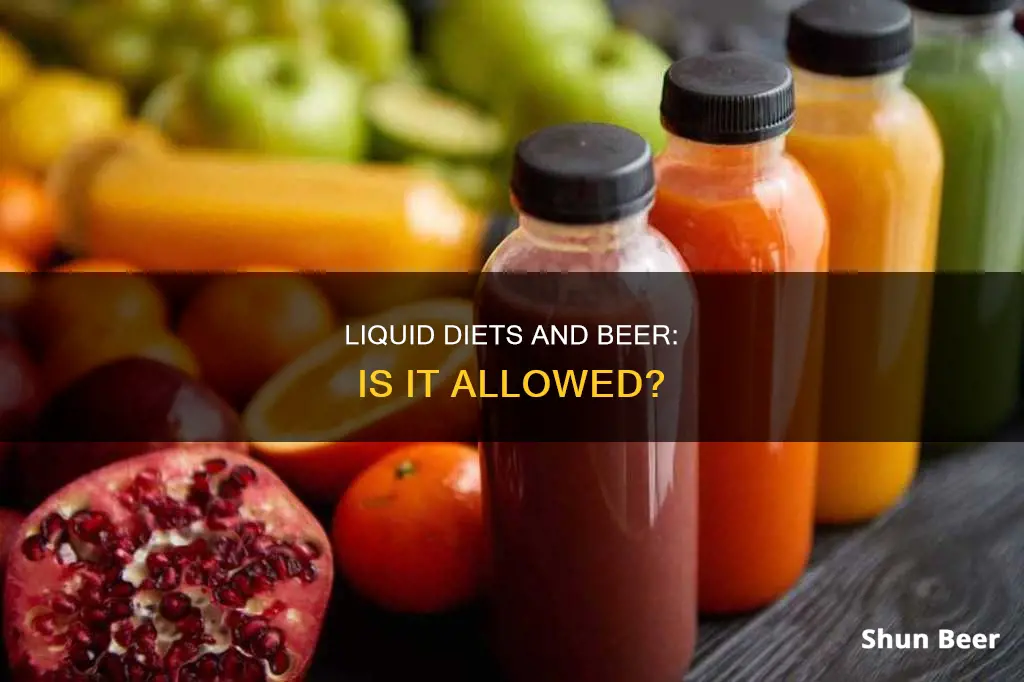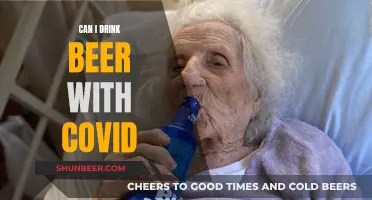
While a liquid diet may bring to mind beverages like juice or soup, some people take it to the extreme, like J. Wilson, who drank only beer and water for 46 days. While Wilson lost 25 pounds, he experienced health issues like kidney problems and back pain. Beer is not recommended for a liquid diet, especially before a colonoscopy, as it can lead to dehydration and interfere with sedatives and the doctor's interpretation of results. Beer is also associated with bigger waists and beer bellies due to its high calorie content, and it is easy to consume too many calories from beer.
What You'll Learn

Beer calories are easy to overdo, leading to a calorie overload
The more you drink, the more calories you consume, and beer calories can add up quickly. This is especially true if you're drinking multiple beers in one sitting or drinking frequently throughout the week. Even light beers, which typically have 100 calories or less, can contribute to a calorie overload if consumed in large quantities.
In addition to the beer calories themselves, the foods often consumed with beer can also contribute to a calorie overload. Alcohol can increase your appetite, and when you're drinking beer at a bar or party, the food on hand is often high in fat and calories, such as pizza, wings, and other fried foods. These extra calories can add up, leading to weight gain and other health issues.
To avoid a calorie overload, it's important to drink in moderation and be mindful of the number of calories in the beer you're consuming. Alternating alcoholic drinks with low-calorie, non-alcoholic beverages can help, as can drinking only on weekends. Having a healthy meal before or with your drinks can also help you resist the temptation of high-calorie bar food.
Beer and Bone Healing: What You Need to Know
You may want to see also

Alcohol increases appetite and is linked to fat in the midsection
Alcohol is known to increase appetite and is linked to fat in the midsection. Alcohol flips the brain into starvation mode, increasing hunger and appetite. This was observed in mice experiments where alcohol activated the brain signals that tell the body to eat more food. The mice were observed to eat more than normal. This neuronal response is believed to be true in humans as well. Alcohol also inhibits the secretion of leptin, a hormone that is responsible for inhibiting hunger and making us feel full.
Alcohol is associated with bigger waists because when you drink alcohol, the liver burns alcohol instead of fat. Alcohol calories are easy to overdo. A typical beer has 150 calories, and drinking several in one sitting can lead to a serious calorie overload. Alcohol also increases your appetite, and the food commonly consumed with alcohol, such as pizza, wings, and other fried foods, tends to be high in fat and calories.
The effects of alcohol on the midsection are complicated. While moderate drinking does not seem to increase abdominal fat, excessive drinking might. Studies have found that those who averaged a single drink per day had the lowest levels of abdominal fat, while those who drank occasionally but consumed four or more drinks in one sitting had the highest levels.
Beer lovers who want to reduce their alcohol intake and watch their waistlines can opt for light beers with 100 calories or less and limit the number of drinks per day. Another option is to drink alcohol only on weekends and to alternate alcoholic drinks with low-calorie, non-alcoholic beverages. It is also a good idea to have a healthy meal before or with your drinks to resist the temptation of high-calorie bar food.
Beer and Zyrtec: Is It Safe to Mix?
You may want to see also

Beer is not recommended before a colonoscopy
Thirdly, alcohol may interact with the sedatives used during the procedure. According to the Iowa Clinic, drinking alcohol may mean you need a higher dose of anaesthesia. Colonoscopy sedatives can also remain in your system, so it is advised that you wait to drink alcohol until at least one full day after your procedure, per Kaiser Permanente. Alcohol can also interfere with certain medications, including anxiety and depression medication, high blood pressure medication, high cholesterol medication, and anti-seizure medication.
Finally, alcohol can alter your thought process and cloud your judgement, which could mean you do not properly follow prep instructions. It is important to have a clear mind when communicating with your doctor and understanding your colonoscopy results.
Beer: A Singer's Remedy or Vocal Cord Myth?
You may want to see also

A liquid diet may be clear or full
A liquid diet is often used for weight loss or to prepare for certain medical procedures. There are two types of liquid diets: clear liquid diets and full liquid diets.
Clear Liquid Diet
On a clear liquid diet, a person can only consume transparent liquids. While vodka, gin, some liquors, and white wine are transparent, they are not acceptable liquids for a clear liquid diet. Clear liquid diets are often recommended before a colonoscopy, a procedure where a doctor checks the large intestine for disease or abnormalities. The goal of a clear liquid diet before a colonoscopy is to ensure the colon is visible.
The following liquids are acceptable on a clear liquid diet:
- Clear fruit juice (without pulp), such as white grape or apple juice
- Clear carbonated drinks, such as 7-Up or ginger ale
- Clear soups and broths, such as vegetable, beef, or chicken broth
- Coffee and tea (without milk or cream)
- Water, mineral water, or club soda
Full Liquid Diet
A full liquid diet is similar to a clear liquid diet, but a person can consume liquids that are not clear. A full liquid diet may be recommended for those who are recovering from certain medical procedures or who are unable to eat solid foods.
The following liquids are acceptable on a full liquid diet:
- Milk
- Ice cream
- Pudding
- Cream soups
- Oatmeal
- Cream of wheat
- Honey
- Puréed vegetables
It is important to note that beer and other alcoholic beverages are not recommended on either a clear or full liquid diet. Alcohol can lead to dehydration and interfere with medical procedures and certain medications.
While a liquid diet may be tempting for weight loss, it is important to consult a healthcare professional before starting any restrictive diet. A balanced and nutritious diet is crucial for overall health and well-being.
How Sales Jobs Can Be Your Dream Career
You may want to see also

A modified liquid diet uses protein powders or meal-replacement shakes
A liquid diet is a short-term weight-loss plan that involves replacing some or all solid foods with liquids. There are two types of liquid diets: clear and full. A clear liquid diet consists of transparent liquids such as tea, coffee, clear fruit juice, and clear carbonated drinks. On the other hand, a full liquid diet includes liquids that are not clear, such as milk, ice cream, pudding, cream soups, oatmeal, cream of wheat, honey, and puréed vegetables.
A modified liquid diet is a type of full liquid diet that uses protein powders or meal-replacement shakes to replace one or two solid meals per day, while still allowing for one normal, solid meal. The goal of this modified approach is to reduce overall calorie intake while ensuring that the body receives a sufficient amount of nutrients that may be lacking in a full liquid diet.
Meal replacement shakes are designed to stand in for an entire meal, providing similar nutritional standards to a solid meal in terms of calories and protein. They are often high in protein to promote feelings of fullness and help preserve muscle mass. However, it is important to note that whole foods are always preferable as they provide a broader range of nutrients that cannot be fully replicated by shakes.
When choosing a meal replacement shake, it is important to consider the following:
- Calorie content: Ensure the shake aligns with your calorie needs, especially if your goal is weight loss or maintenance.
- Protein and fiber content: Look for shakes with at least 15-20 grams of protein and more than 5 grams of fiber.
- Nutrient balance: Opt for shakes with a variety of vitamins and minerals to meet your daily requirements.
- Natural ingredients: Prioritize shakes with whole foods listed at the top of the ingredients list, such as fruits and vegetables.
- Artificial ingredients: Be mindful of added artificial ingredients, which can be a downside of some meal replacement shakes.
While meal replacement shakes can be a convenient option for weight management or as a supplemental nutrition source, they should not be the sole source of nutrition. It is generally recommended to consult a doctor or registered dietitian before starting a liquid diet or incorporating meal replacement shakes to ensure it aligns with your specific health needs and goals.
Fighting for Country, Not Allowed a Beer: Age Conundrum
You may want to see also
Frequently asked questions
No, beer is not considered a clear liquid and is not recommended as part of a liquid diet. Clear liquids are transparent and include coffee, tea, clear soup broths, clear fruit juice, and clear carbonated drinks.
A liquid diet is a diet that consists only of liquids. There are two types: clear and full-liquid. A clear liquid diet includes only transparent liquids, while a full-liquid diet includes all liquids, clear or not.
Drinking beer or other alcoholic beverages before a colonoscopy can lead to dehydration and interfere with the doctor's interpretation of your colon health. Alcohol may also interact with the sedatives used during the procedure and cloud your judgment, making it difficult to properly follow prep instructions.







